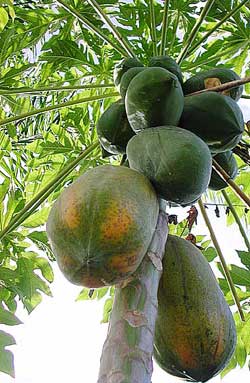Papaya trees are often attacked by pests and diseases such as root nematodes, red spider mites that cause yellowing leaves, mealybugs, and thrips that sap the plant and fruit of nutrients. They also transmit viral diseases that cause leaf curl and yellowing, or mottling with green and white.
 |
|
Papaya Tree (Photo: toptropicals) |
Papaya trees may wilt and drop leaves due to drought or lack of water, but they can recover the following spring. However, trees infected with viruses cannot be saved.
To mitigate these issues, when planting papayas, we need to pay attention to the following steps:
– In addition to selecting good soil with low debris to avoid root nematodes and ensuring quick drainage during the summer rains, it is also convenient for watering in the fall and winter. The papaya garden should be positioned to shield from the north and northeast winds. If not, barriers such as windbreak trees should be planted. In mountainous areas, avoid planting papayas in valleys or places where frost commonly occurs.
– When planting papayas, it is essential to apply a substantial amount of well-rotted organic fertilizer. Papayas thrive on nutrients. The more quality fertilizer applied, the healthier the trees will grow, with dark green and abundant leaves, contributing to higher yields. Each tree should ideally have 30-35 leaves, ensuring stable water availability. Furthermore, healthy plants will be better equipped to withstand cold weather and pest infestations later on.
– During the fall and winter, it is crucial to maintain moisture for the plants. The garden soil should never be allowed to dry out completely. When watering, it can be done with a spray to mimic a rain shower or by flooding the furrows to allow the soil to absorb sufficient water, then draining off any excess. Additionally, once a month, combine watering with 2-3 applications of Bordeaux mixture or Copper Oxychloride. These substances provide calcium and trace amounts of copper, helping the plants produce chlorophyll and reducing the risk of white leaf diseases or poor greenness.
The phenomenon of papaya trees breaking at the stem is caused by scale insects. These insects cluster together in patches resembling small scales, about half the size of a millet seed, and remain stationary. They blend in with the color of the tree bark, making them difficult to detect. Scale insects extract sap from the stem, creating wounds that allow fungal infections to enter, leading to rot and causing the plant to topple. Upon discovery, simply using a rough cloth to wipe vigorously will eliminate the pests. Early prevention will help the plants avoid death from collapse.
Ripe papayas are a nutritious fruit, containing up to 0.6% protein, 0.1% fat, 8.3-8.5% sugar, and 60-20% of vitamins B and C, particularly boasting 2,000-3,500 units of vitamin A, which is ten times higher than bananas, five times that of avocados, guavas, and nearly double that of mangoes. However, if the plants are diseased or suffer from drought, the fruit may have a bitter taste. Papayas contain a significant amount of the enzyme Papain, which softens meat. Therefore, individuals who are sick or have the flu should avoid consuming it to prevent further discomfort.



















































